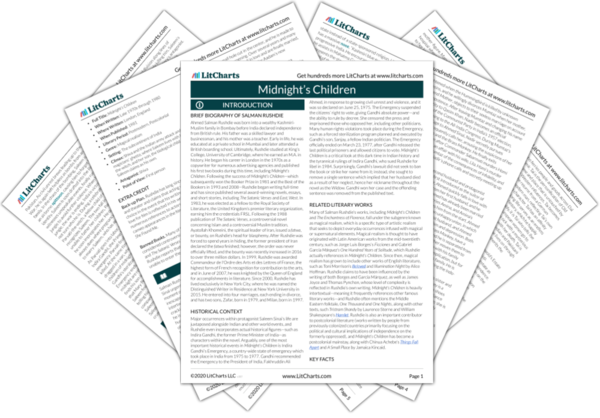Welcome to the LitCharts study guide on Salman Rushdie's Midnight’s Children. Created by the original team behind SparkNotes, LitCharts are the world's best literature guides.
Midnight’s Children: Introduction
Midnight’s Children: Plot Summary
Midnight’s Children: Detailed Summary & Analysis
Midnight’s Children: Themes
Midnight’s Children: Quotes
Midnight’s Children: Characters
Midnight’s Children: Terms
Midnight’s Children: Symbols
Midnight’s Children: Literary Devices
Midnight’s Children: Theme Wheel
Brief Biography of Salman Rushdie

Historical Context of Midnight’s Children
Other Books Related to Midnight’s Children
- Full Title: Midnight’s Children
- When Written: Late 1970s through 1980
- Where Written: London, England
- When Published: 1981
- Literary Period: Postmodern, Postcolonial
- Genre: Magical realism
- Setting: The subcontinent of India
- Climax: Shiva and the Indian army attack and destroy the magicians’ ghetto, where Saleem lives with his wife, Parvati-the-witch, and her son, the biological child of Shiva whom Saleem claims as his own.
- Antagonist: Shiva
- Point of View: First person
Extra Credit for Midnight’s Children
Back-up Plan. Rushdie has long since been a huge fan of film and theater and claims that acting was his back-up career choice in the event that his writing failed to take off. Rushdie’s love for film is reflected in his writing, which is infused with numerous references to actors and movies, and he even made cameo appearances in the films Bridget Jones’s Diary and Then She Found Me.
Banned Books. Many of Salman Rushdie’s works are considered controversial, especially within Muslim societies, and The Satanic Verses has been banned in several countries. Rushdie reports that when his mother lived in Pakistan, he was unable to enter the country to visit her.







